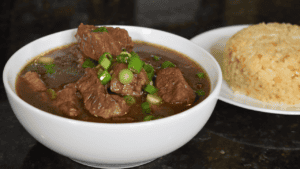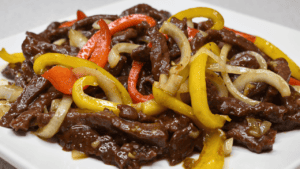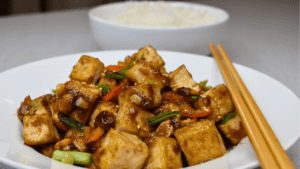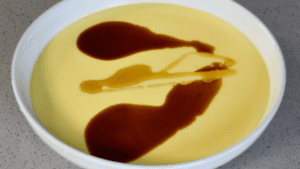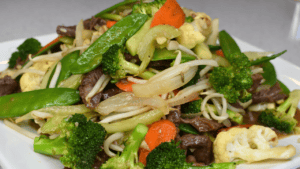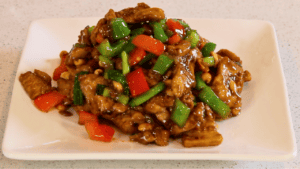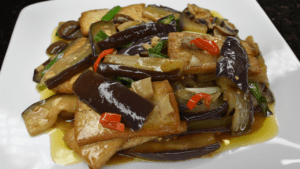Easy Bok Choy Stir Fry
Bok choy stir fry is a popular Chinese dish made with bok choy (a type of Chinese cabbage), stir fried with various vegetables and sometimes meat or tofu. It is typically cooked in a wok or frying pan with oil, garlic, ginger, and soy sauce for flavor.
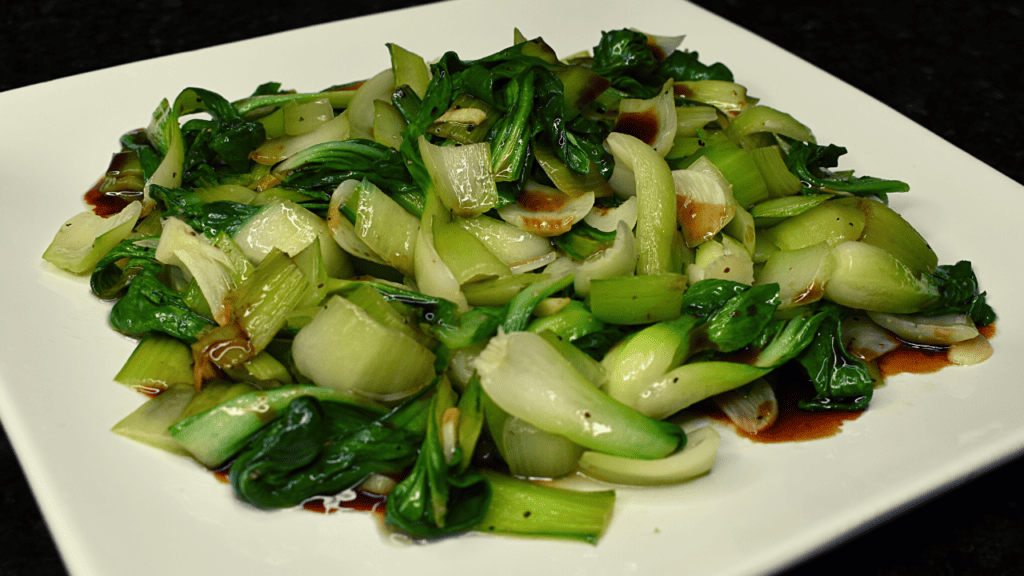
Discover the Delight of Bok Choy Stir Fry in Your Own Kitchen
Are you ready to elevate your home cooking with a dish that’s as nutritious as it is delicious? Bok choy stir fry is a culinary delight that marries simplicity with exotic flavors. Whether you’re a seasoned home cook or a beginner, this recipe offers a perfect opportunity to explore the tastes of Asian cuisine right in your kitchen. In this blog post, we’ll guide you through every step of making a delectable bok choy stir fry, share tips on selecting the freshest ingredients, and even offer creative variations to suit your dietary preferences. Let’s get started on this flavorful adventure!
Understanding Bok Choy
A Brief History and Cultural Significance
Bok choy, also known as Chinese cabbage, is a staple in Asian cuisine and has been cultivated for thousands of years. Originating from China, it has made its way into kitchens worldwide, beloved for its crisp texture and subtle flavor. This leafy green is rich in vitamins A, C, and K, and it packs a nutritional punch in every bite. Its versatility makes it a popular choice in various dishes, from soups to stir-fries.
Historically, bok choy has been treasured not only for its culinary uses but also for its medicinal properties. In traditional Chinese medicine, it’s believed to promote digestive health and strengthen the immune system. The growing popularity of bok choy in Western countries is a testament to its adaptability and health benefits.
Whether you’re cooking for health reasons or simply for its delightful taste, bok choy is a fantastic ingredient to incorporate into your meals. Its cultural significance and rich history add depth to your cooking experience, making every bite a celebration of tradition and flavor.
Selecting and Preparing Bok Choy
Tips for Choosing the Freshest Bok Choy
When shopping for bok choy, look for vibrant green leaves and firm, crisp stalks. Avoid any that appear wilted or have brown spots. Freshness is key to retaining its nutritional benefits and achieving that perfect crunch in your stir fry. Farmers’ markets and local grocery stores often provide the freshest produce, so if possible, source your bok choy from these places.
Proper Cleaning and Cutting Techniques
To prepare bok choy for cooking, start by rinsing it thoroughly under cold water to remove any dirt or grit. Pay special attention to the base where soil can accumulate. After washing, pat the bok choy dry with a clean towel. Separate the leaves from the stalks, as the thicker stalks may require a slightly longer cooking time. Slice the stalks into bite-sized pieces and keep the leaves whole or halved, depending on their size.
Proper preparation ensures that every part of the bok choy cooks evenly, preserving its delicate flavor and crisp texture. These simple steps will set the stage for a delicious stir fry that highlights the best of this versatile vegetable.
Essential Ingredients for Bok Choy Stir Fry
Focusing on Fresh, Local Produce
Creating an authentic bok choy stir fry starts with sourcing the finest ingredients. Apart from bok choy, you’ll need other fresh produce like garlic and ginger, both of which add depth and aroma to the dish. Selecting organic and locally grown ingredients whenever possible not only supports your community but also enhances the flavor of your meals.
Other Key Ingredients
Your pantry staples will come into play here. You’ll need olive oil for sautéing, sugar, salt, and ground black pepper for seasoning, and a simple sauce made from oyster sauce, soy sauce, sesame oil, and water. These ingredients combine to create a harmonious balance of flavors that define a classic bok choy stir fry.
The inclusion of high-quality sauces, such as oyster and soy sauce, is crucial. They impart a rich umami flavor that elevates the dish from ordinary to extraordinary. With these essential ingredients on hand, you’re well-prepared to whip up a satisfying stir fry that your family and friends will love.
Step-by-Step Cooking Instructions
Crafting a Delicious Bok Choy Stir Fry at Home
Now that you have your ingredients ready, it’s time to bring them together in a mouthwatering bok choy stir fry. Follow these detailed steps for a foolproof cooking process:
- Prepare the Bok Choy: Rinse thoroughly, separate leaves from stalks, and cut into bite-sized pieces.
- Heat the Oil: In a wok or large skillet, heat olive oil over medium-high heat. This ensures even cooking and prevents sticking.
- Add Aromatics: Toss in the sliced garlic and ginger, stirring for about a minute until they’re fragrant. Their aroma is the backbone of your stir fry.
- Cook the Stalks: Introduce the bok choy stalks to the wok, cooking for three minutes until they begin to soften.
- Wilt the Leaves: Add the leaves, sprinkle with sugar, salt, and pepper, and cook for two more minutes until they wilt.
- Prepare the Sauce: In a small saucepan, mix oyster sauce, soy sauce, sesame oil, and water. Cook until slightly thickened.
- Combine and Serve: Drizzle the sauce over the bok choy, serve warm, and enjoy the delightful fusion of flavors.
With these steps, you’ll master the art of bok choy stir fry, bringing a taste of Asian cuisine to your table effortlessly.
Variations and Customizations
Personalizing the Recipe for Different Tastes
One of the joys of cooking at home is tailoring recipes to suit personal preferences and dietary needs. Bok choy stir fry is incredibly adaptable, allowing you to experiment with a variety of add-ins and flavors.
Adding Protein
For a heartier meal, consider adding protein such as tofu, chicken, or shrimp. Marinate your choice of protein in a bit of soy sauce and ginger before cooking it alongside the bok choy. This adds richness and satisfies even the hungriest diners.
Exploring Spice Levels
If you enjoy a bit of heat, introduce chili flakes or a dash of sriracha to your stir fry. Adjusting spice levels can transform the dish, providing an exciting kick for those who love bold flavors.
Accommodating Dietary Restrictions
For those with dietary restrictions, replace oyster sauce with a vegetarian alternative or tamari for a gluten-free version. The flexibility of this dish ensures everyone can enjoy its delicious flavors.
Serving Suggestions
Pairing Bok Choy Stir Fry with Other Dishes
Bok choy stir fry is versatile enough to stand alone as a main dish, but it also pairs wonderfully with other foods. Here are a few suggestions for creating a balanced meal:
Complementary Sides
Serve your stir fry with steamed jasmine rice or fluffy quinoa for a delightful contrast in textures. These grains soak up the savory sauce, enhancing every bite.
Asian-Inspired Additions
Consider pairing your stir fry with spring rolls or dumplings for an authentic Asian dining experience. These appetizers complement the flavors of bok choy and make your meal feel complete.
A Light and Fresh Approach
For a lighter option, pair your stir fry with a simple cucumber salad or a side of fresh edamame. These additions bring a refreshing balance to the meal, perfect for warm weather dining.
Conclusion and Encouragement
Recapping the Recipe and Inviting Exploration
Congratulations! You’ve learned how to prepare a delicious bok choy stir fry at home, bringing global flavors to your kitchen. This dish is a celebration of fresh ingredients and simple techniques, resulting in a meal that’s both nourishing and satisfying.
Bok choy stir fry is more than just a recipe; it’s an opportunity to explore new flavors and enhance your culinary skills. Whether you’re cooking for yourself or sharing with loved ones, this dish is sure to impress.
I encourage you to try this recipe and share your experience with friends and fellow home cooks. Your culinary adventure doesn’t stop here—there are countless ways to personalize and expand on this delightful dish. Happy cooking!
Frequently Asked Questions
How to Prep Bok Choy for Stir Fry?
To prep bok choy, rinse it thoroughly, separate the leaves from the stalks, and slice both into manageable pieces. This ensures even cooking and optimal flavor.
How Long Does Bok Choy Need to Be Cooked For?
Bok choy cooks quickly, with stalks taking about three minutes and leaves just two. This brief cooking time maintains its crisp texture and fresh flavor.
Is Bok Choy Better Steamed or Boiled?
While both steaming and boiling are options, stir frying is often preferred for its ability to preserve nutrients and enhance flavor through aromatics like garlic and ginger.
Do You Have to Soak Bok Choy?
There’s no need to soak bok choy. A thorough rinse is sufficient to remove dirt and grit, preparing it for cooking.
What Does Bok Choy Pair Well With?
Bok choy pairs beautifully with grains like rice and quinoa, proteins such as chicken or tofu, and light sides such as cucumber salad or edamame.
What Is the Secret to a Good Stir Fry?
The secret to a great stir fry lies in high heat, fresh ingredients, and a balance of flavors, such as the umami from soy sauce and oyster sauce.
How to Make Stir Fry Taste Amazing?
To make your stir fry shine, focus on fresh aromatics, like garlic and ginger, and finish with a balanced sauce that ties all elements together.
More Delicious Recipes You’ll Love
- Creamy Tuscan Salmon Recipe – A mouth-watering Italian dish that combines the richness of cream sauce with the delicate flavor of salmon. The dish originated in Tuscany, a region known for its exquisite cuisine and culinary traditions.
- Chicken Tenders – Chicken tenders, also known as chicken fingers or chicken strips, are a classic fast food dish that originated in the United States. They consist of small strips of chicken meat that are typically battered and fried.
- Garlic Butter Shrimp – Delicious and flavorful seafood dish that can be made with ease at home. The recipe combines succulent shrimps, butter, garlic, and various herbs and spices to make a delightful meal.
- Baked Salmon – Delicious and healthy dish that combines the delicate flavors of fresh salmon with the rich and aromatic seasonings of various herbs and spices.
- Kung Pao Chicken – Kung Pao chicken is a popular Chinese dish that consists of diced chicken, peanuts, and vegetables in a spicy sauce.
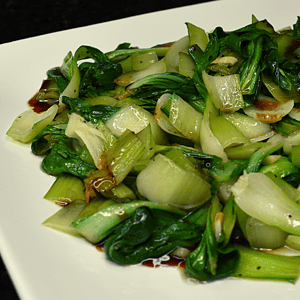
Bok Choy Stir Fry
Ingredients
- 1½ lbs bok choy
- 1 tbsp olive oil
- 5 cloves garlic sliced
- 1 small ginger cut into strips
- 1 tsp sugar
- a pinch of salt to taste
- ground black pepper
For the Sauce
- 1 tbsp oyster sauce
- 1 tsp soy sauce
- 1 tsp sesame oil
- 2 tbsp water
Instructions
- Rinse the bok choy well and pat it dry. Separate the leaves from the stalks.
- Heat olive oil in a wok or large skillet over medium-high heat.
- Add sliced garlic and ginger, stirring for about a minute until fragrant.
- Add bok choy stalks and cook for three minutes until they start to soften.
- Toss in the bok choy leaves, sprinkle with sugar, salt, and pepper, and continue cooking for two minutes, or until the leaves wilt.
- Transfer the bok choy to a plate.
- In a bowl, mix oyster sauce, soy sauce, sesame oil, and water. Pour this mixture into a small saucepan over medium high heat and cook until it slightly thickens.
- Remove from heat and drizzle the sauce over the bok choy.
- Serve warm and enjoy immediately!
